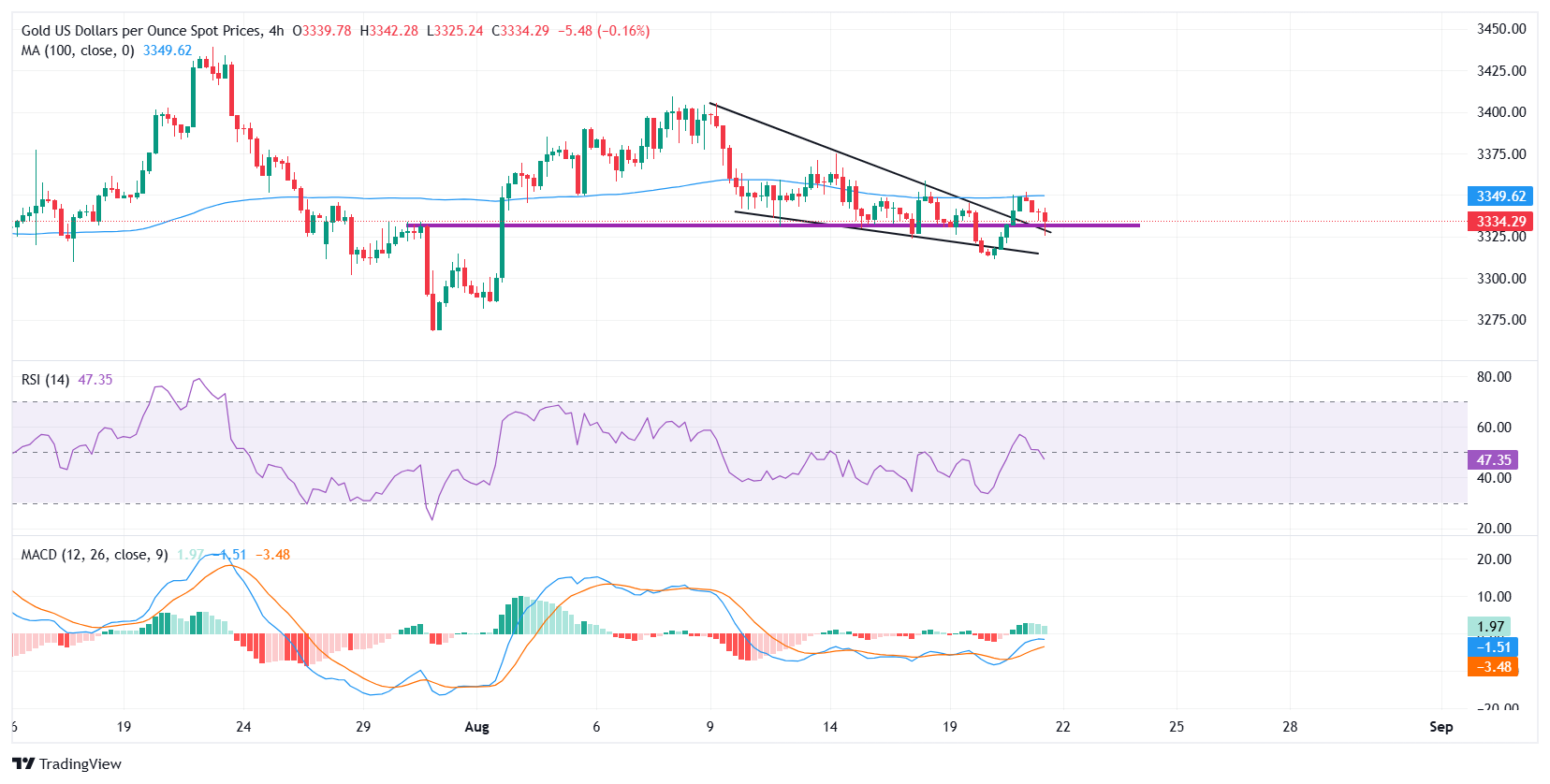Created
: 2025.08.21














![]() 2025.08.21 21:18
2025.08.21 21:18
Gold (XAU/USD) edges lower on Thursday, retreating modestly after Wednesday's sharp rebound from three-week lows, as the metal failed to clear technical resistance near $3,350. A steady US Dollar (USD) and firm Treasury yields are weighing on the precious metal, as traders digest the Federal Reserve's (Fed) July meeting Minutes and position ahead of Fed Chair Jerome Powell's remarks at the Jackson Hole symposium on Friday.
At the time of writing, XAU/USD is trading around $3,340 during the European session, having posted an intraday high of $3,352. The price action reflects a cautious consolidation, with traders reluctant to take fresh positions and keeping the metal confined within a narrow range.
Attention now turns to upcoming US economic releases, with weekly Initial Jobless Claims and the preliminary S&P Global Purchasing Managers' Index (PMI) surveys scheduled later on Thursday. These data points could offer fresh insight into the labor market and business activity, shaping near-term expectations for the Fed's policy path.
The Fed Minutes, released Wednesday, revealed that most officials viewed inflation linked to US President Donald Trump's newly imposed reciprocal tariffs as a greater risk than a cooling labor market. Policymakers noted that tariff effects may take time to filter through, as many businesses are expected to gradually pass higher costs on to consumers. Several participants also anticipated softer growth in the second half of the year as weaker income restrains household spending. While a few members argued for earlier rate cuts, the majority preferred to leave policy unchanged, with dissent coming from Governors Christopher Waller and Michelle Bowman. Looking ahead, officials stressed that the path of rate cuts will depend on incoming data and the persistence of tariff-driven inflation pressures.

Gold (XAU/USD) declines on Thursday after Wednesday's sharp rebound that briefly lifted prices above the upper boundary of a falling wedge pattern on the 4-hour chart. The breakout attempt stalled at the 100-period Simple Moving Average (SMA) near $3,350, where sellers re-emerged.
Currently, the metal is retesting the upper wedge line, which closely aligns with the horizontal support zone around $3,330. This area has become the immediate battleground between bulls and bears.
The Relative Strength Index (RSI) has slipped back below the neutral 50 mark on the 4-hour chart, reflecting weakening upside momentum and highlighting that yesterday's rebound was more corrective than a trend-changing move. A deeper slide toward the 40-42 region would reinforce bearish pressure, while a recovery back above 55-60 would be needed to tilt the bias back in favor of buyers.
The Moving Average Convergence Divergence (MACD) indicator's lines are flattening near the zero axis, while the green histogram bars are contracting after a brief positive run. This suggests the bullish momentum from Wednesday's rebound is fading. A rollover into negative territory would confirm renewed bearish momentum, particularly if the price loses the $3,330 floor.
Overall, the near-term outlook hinges on the $3,330 support zone. A sustained hold above this level would keep the wedge breakout intact and allow bulls to challenge higher resistance levels. Conversely, a decisive break below $3,330 would invalidate the breakout and expose downside targets at $3,310 and $3,300.
Gold has played a key role in human's history as it has been widely used as a store of value and medium of exchange. Currently, apart from its shine and usage for jewelry, the precious metal is widely seen as a safe-haven asset, meaning that it is considered a good investment during turbulent times. Gold is also widely seen as a hedge against inflation and against depreciating currencies as it doesn't rely on any specific issuer or government.
Central banks are the biggest Gold holders. In their aim to support their currencies in turbulent times, central banks tend to diversify their reserves and buy Gold to improve the perceived strength of the economy and the currency. High Gold reserves can be a source of trust for a country's solvency. Central banks added 1,136 tonnes of Gold worth around $70 billion to their reserves in 2022, according to data from the World Gold Council. This is the highest yearly purchase since records began. Central banks from emerging economies such as China, India and Turkey are quickly increasing their Gold reserves.
Gold has an inverse correlation with the US Dollar and US Treasuries, which are both major reserve and safe-haven assets. When the Dollar depreciates, Gold tends to rise, enabling investors and central banks to diversify their assets in turbulent times. Gold is also inversely correlated with risk assets. A rally in the stock market tends to weaken Gold price, while sell-offs in riskier markets tend to favor the precious metal.
The price can move due to a wide range of factors. Geopolitical instability or fears of a deep recession can quickly make Gold price escalate due to its safe-haven status. As a yield-less asset, Gold tends to rise with lower interest rates, while higher cost of money usually weighs down on the yellow metal. Still, most moves depend on how the US Dollar (USD) behaves as the asset is priced in dollars (XAU/USD). A strong Dollar tends to keep the price of Gold controlled, whereas a weaker Dollar is likely to push Gold prices up.
![]()
Created
: 2025.08.21
![]()
Last updated
: 2025.08.21

FXStreet is a forex information website, delivering market analysis and news articles 24/7.
It features a number of articles contributed by well-known analysts, in addition to the ones by its editorial team.
Founded in 2000 by Francesc Riverola, a Spanish economist, it has grown to become a world-renowned information website.
We hope you find this article useful. Any comments or suggestions will be greatly appreciated.
We are also looking for writers with extensive experience in forex and crypto to join us.
please contact us at [email protected].
Disclaimer:
All information and content provided on this website is provided for informational purposes only and is not intended to solicit any investment. Although all efforts are made in order to ensure that the information is correct, no guarantee is provided for the accuracy of any content on this website. Any decision made shall be the responsibility of the investor and Myforex does not take any responsibility whatsoever regarding the use of any information provided herein.
The content provided on this website belongs to Myforex and, where stated, the relevant licensors. All rights are reserved by Myforex and the relevant licensors, and no content of this website, whether in full or in part, shall be copied or displayed elsewhere without the explicit written permission of the relevant copyright holder. If you wish to use any part of the content provided on this website, please ensure that you contact Myforex.
Myforex uses cookies to improve the convenience and functionality of this website. This website may include cookies not only by us but also by third parties (advertisers, log analysts, etc.) for the purpose of tracking the activities of users. Cookie policy